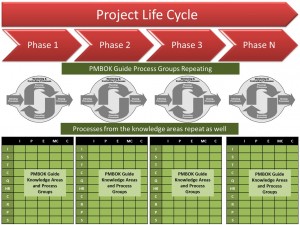This post is an Appendix in a book we are finalizing at this time to send to the publisher; Redefining the Basics of Project Management is expected in the market by the end of March 2014.
It is common to hear the following question: “how much effort should we spend on planning” or “how long should the project planning phase be.”
Our answer is
“first, there is no planning phase, and second planning is continuous throughout the project.”
In more than one place in this book [Redefining the Basics of Project Management], we discussed the PMBOK® Guide process groups and compared them to the project life span. The guide presents that the process groups repeat in every phase (or stage). Consequently, the planning process group and processes repeat in every phase. This was one of the reasons why in the CAM2P™ model, there is no ‘planning’ phase or stage. Yes, in the methodology, one will develop a project management plan and a project detailed plan but none of the phases or the stages carries the word ‘planning’ in its name.
In addition to the above, there is another reason why we highly recommend to organizations not to have a ‘planning phase’. We have already established that planning takes place in every phase and stage. We even have to plan the project close stage. Therefore, planning is not a stage – it is a process – a process group per the PMBOK® Guide. If an organization chooses to have a planning stage, the risk is that practitioners will confuse planning as a process versus planning as a stage. This confusion can limit planning effort to this phase, which would increase the threats to attaining the project objectives. Just to clarify – planning here refers to all planning processes from all project management functions, such as scope, time, cost, risk, quality, safety, and others.
Now, if one shift the question (from the start of this appendix) to “Within a phase, or stage, how long planning should takes?” The answer, “it depends.” Yes, it depends on the project size, complexity, importance, among other factors. As a time ratio, {time to plan divided by total time for the phase}, the ratio would be low for a project that are simple and highly repetitive, but for complex project, the ratio would be higher. What are the actual ratios and can we defined them proportionally? In our views, this is not relevant.
We close this topic by reminding the reader – this is not science; project management, especially planning, is a blend between, science, art, and a bit of psychology.
_____________________________________________________________________________________________
In the SUKAD Essentials of Project Management Workshop we integrate the process groups with a project life span model. This workshop is also linked to the book that we are working on, in addition to a software application that is under development!
Let us know what you think – comment on this post!


Trackbacks/Pingbacks